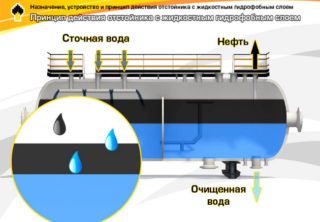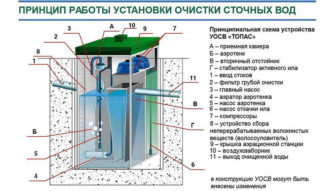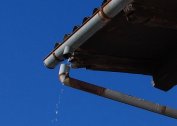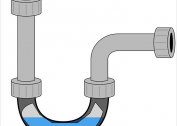Settles are called artificial reservoirs or natural reservoirs in which suspended impurities are separated, floated or deposited from industrial and domestic wastewater by gravity or using reagents. The sewage sump can be used as a filter for preliminary and final wastewater treatment in the sewage system.
The primary stage is the separation of mechanical impurities or suspended particles and the beginning of biological treatment of effluents. In sludge biocoagulators, activated sludge is mixed with the source water, colloidal and finely dispersed impurities are separated. Secondary sedimentation tanks of treatment facilities, final treatment devices, are called environmental, since after them the clarified water is discharged into natural reservoirs.
Scope of use
They are used in water supply and sanitation systems in industry and personal households, for the treatment of sewage, waste effluent during hydromechanization in quarries and mines, in mining and processing plants, and for drinking water supply.
Purpose:
- protection of surface water bodies and lands from pollution;
- reduction of equipment wear;
- capture of components;
- hydromechanization of earthwork and mining.
During the construction of structures and roads create settling ponds for the accumulation and clarification of surface runoff. Industrial effluents contain fatty substances that adversely affect the operation of treatment systems:
- cause blockages;
- contribute to metal corrosion, leading to the destruction of the pipeline.
To prevent consequences, grease traps are installed in the sewer channels, which are made in the form of a box with a tire. Its functional purpose is to retain and remove oil and fat.
In the spring thaw and the rainy season, sewers of various kinds are washed off into the sewer. Storm wells and chambers, which are made of concrete, allow reducing pollution. They collect storm flows from a certain territory, therefore, in the calculation there is necessarily a volume that can accommodate the discharge of water from this site. Gabions are used to capture contaminants in effluents from roads.
To remove some balanced connections, flocculators with an integrated camera are mounted. In devices, using laminar flows or turbulent flows, particles collide with each other and interact with reagents, which contributes to the rapid flocculation and removal of sediment.
 The purpose of the ball sump in the removal of water and salts from oil before using natural resources in the production of gasoline. Hydrophobic sedimentation tanks are used in oil production to separate formation waters for their further use, cascaded - to separate washing solutions from oil when washing vessels.
The purpose of the ball sump in the removal of water and salts from oil before using natural resources in the production of gasoline. Hydrophobic sedimentation tanks are used in oil production to separate formation waters for their further use, cascaded - to separate washing solutions from oil when washing vessels.
In rolling mills, settling tanks are used for collecting scale. In ceramic workshops, the drains contain a large amount of clay, which leads to blockages in the sewage system if it is not removed on time with the help of sedimentation tanks.
After aeration during biochemical wastewater treatment, water enters the sludge trap, from where activated sludge is returned to the aeration tanks for further continuous water treatment.
Wastewater must be separated from household liquid wastes - waste products or feces pumped out of cesspools. For this purpose, concrete tanks are used.To place them, polygons or filtering fields are used.
Homeowners make septic tanks for their home gardens with their own hands.
Principle of operation
 The classic view of the precipitating device is a vertical sump having a cylindrical shape. Contaminated water flows down the central pipe, falling onto a reflective shield. After this, the flow changes direction, and the dispersed suspension precipitates. The clarified water rises up to the edge of the overflow, after which it is poured into the peripheral tray to collect clean water. Sludge is removed through the sludge from the settling section.
The classic view of the precipitating device is a vertical sump having a cylindrical shape. Contaminated water flows down the central pipe, falling onto a reflective shield. After this, the flow changes direction, and the dispersed suspension precipitates. The clarified water rises up to the edge of the overflow, after which it is poured into the peripheral tray to collect clean water. Sludge is removed through the sludge from the settling section.
The partition creating the overflow edge prevents the ingress of contaminants discarded from the reflective shield.
Classification and arrangement of water sumps
 The advantage of settling over other methods of separation of suspensions in the cheapness of the process. The subsequent filtration is accelerated if the filtered material is pre-thickened. For this reason, sedimentation is used during the initial cleaning phase to remove suspended solids.
The advantage of settling over other methods of separation of suspensions in the cheapness of the process. The subsequent filtration is accelerated if the filtered material is pre-thickened. For this reason, sedimentation is used during the initial cleaning phase to remove suspended solids.
Types of sedimentation tanks depending on the operating mode:
- contact (periodic action);
- with continuous supply of the initial suspension at a low speed;
- semi-continuous mode.
Periodic thickeners seem to represent pools of shallow depth. After filling the tank, time is allocated for the sedimentation of suspended solids and colloidal particles to the bottom of the structure. The clarified water is drained through taps located above the sedimentary level. Sludge in the form of a viscous liquid mass is scooped out manually or poured into a pipe hole in the lower part of the device.
Sewage treatment tanks in the direction of movement of the feed mixture are divided into two types:
- horizontal
- vertical.
Horizontal sump
The design of the horizontal sump is a tank with several corridors. Conditional dividing by height distinguishes the working area and the sludge part. The former is undergoing a deposition process, while the latter collects settled sludge. According to the norms, a distance of 25 cm is foreseen between the zones. The sediment is collected in the pit at the place where the effluents arrive, from where it is pumped out or raked.
Vertical sump
 It is applied at small volumes of initial liquid. The vertical sump is in the form of a cylinder with a conical base. It is equipped with several drain taps located at different levels of height. Through a special hatch, sediment is removed from below.
It is applied at small volumes of initial liquid. The vertical sump is in the form of a cylinder with a conical base. It is equipped with several drain taps located at different levels of height. Through a special hatch, sediment is removed from below.
The shape and size of sedimentation tanks are selected depending on the concentration of the suspension and size. With increasing concentration and particle size, the diameter of the thickener decreases. An increase in temperature reduces the viscosity of the liquid, which increases the rate of purification.
Semi-continuous
 Find application in the system for the treatment of significant volumes of wastewater. Execution in the form of large concrete tanks or a system of series-connected sumps.
Find application in the system for the treatment of significant volumes of wastewater. Execution in the form of large concrete tanks or a system of series-connected sumps.
The principle of operation is the continuous supply of the original liquid and the discharge of clarified water. Precipitated sludge is removed periodically. To increase the deposition area, constructions with inclined partitions are used. They repeatedly change the direction of flow from the bottom up and back. At the same time, the residence time of the initial liquid in the tank increases, and better water purification is achieved.
Continuous action
They are used in industrial production. Settling tanks of continuous design are subdivided into one-, two- and many-tier. The use of two-tier and multi-tier devices is caused by the degree of pollution of effluents.
With paddle stirrers
 Radial sump - one of the special cases of vertical apparatus. The movement of the source water occurs under the action of centrifugal force from the center to the periphery.Row agitators are cylindrical. The initial suspension is fed into the tank continuously. Mixers have inclined blades. During their rotation, on the one hand, the sediment partially shakes, and on the other hand, is dehydrated.
Radial sump - one of the special cases of vertical apparatus. The movement of the source water occurs under the action of centrifugal force from the center to the periphery.Row agitators are cylindrical. The initial suspension is fed into the tank continuously. Mixers have inclined blades. During their rotation, on the one hand, the sediment partially shakes, and on the other hand, is dehydrated.
Sludge containing a large amount of water is sent to another sump, where the sediment is washed and sedimented. When using the sump system, the sludge is dehydrated up to 98%.
The counterflow principle is applied, in which the sediment moves in the direction of the tanks connected in series, and the clarified liquid flows in the opposite direction to make up for losses in previous devices.
The advantages of rowing machines:
- continuity of work;
- high productivity with sediment removal up to 3000 tons per day;
- change in sludge density through capacity control;
- effective dewatering of the removed sludge;
- fully automated process.
The main disadvantage of the bulkiness of the device. The diameter varies from 1.8-30 m. In industrial plants, the diameter of the sedimentary tank can be 100 m. For compactness, in order to save space in production facilities, multi-tier sedimentation tanks are used. They are a structure consisting of several modules placed on top of each other.
In turn, multi-tiered devices are divided into two types: closed and balanced.
In the precipitating devices of the first type, the mixers are mounted on the same shaft with one drive. To eliminate leaks, sealing glands are used. The process of sludge discharge, as well as the discharge of clarified liquid, is carried out separately for each sump.
Sequential sludge removal is used in balanced settling tanks. The sediment from the previous merges into a glass of each subsequent tier. As you move down the sludge thickens and is removed from the lower tier. In this case, sealing glands in the previous tiers are not required, since in them the pressure of the sediment on the bottom is much lower than in the lower sump.
With conical shelves
 The distribution of the suspension occurs using conical shelves pointing down. Source water enters their surface through openings located through one shelf. The clarified water rises upstream to the top of the structure. Gravitational force carries particles to the bottom, they do not have time to change their direction due to inertia. Advantage:
The distribution of the suspension occurs using conical shelves pointing down. Source water enters their surface through openings located through one shelf. The clarified water rises upstream to the top of the structure. Gravitational force carries particles to the bottom, they do not have time to change their direction due to inertia. Advantage:
- no moving parts;
- simple operation.
For separation of emulsions
 Horizontal devices designed to separate emulsions are equipped with baffle plates with holes that prevent disturbance from the incoming emulsion. The cross section provides a quiet laminar (moving the water mass in layers) fluid flow. The flow rate is several mm / s. The emulsion is divided into its component parts: light and heavy. A lighter fluid is drained through a hole in the upper part, a heavy one is drained through a drain in the lower part of the device.
Horizontal devices designed to separate emulsions are equipped with baffle plates with holes that prevent disturbance from the incoming emulsion. The cross section provides a quiet laminar (moving the water mass in layers) fluid flow. The flow rate is several mm / s. The emulsion is divided into its component parts: light and heavy. A lighter fluid is drained through a hole in the upper part, a heavy one is drained through a drain in the lower part of the device.
Thin layer sedimentation tank
 It is used to purify water using plates that divide the volume of the apparatus into tiers. In each tier, water is freed from sludge that slides down due to the inclination of the plates. The angle of their slope affects the efficiency of sediment removal and should be 55-60 degrees.
It is used to purify water using plates that divide the volume of the apparatus into tiers. In each tier, water is freed from sludge that slides down due to the inclination of the plates. The angle of their slope affects the efficiency of sediment removal and should be 55-60 degrees.
Operation and maintenance
The effectiveness of sewage treatment plants depends on competent operation, involving control of the volume of effluents and their composition. The limited capacities of sewage treatment systems are most prone to malfunctions.
Negative factors affecting the sewage treatment system:
- overload;
- volley discharges;
- groundwater rise;
- non-compliance with the repair schedule;
- violation of the rules of operation.
For the normal operation of the primary sedimentation tanks, the following rules should be observed:
it is forbidden to exceed the permissible load for the project;
evenly distribute wastewater in the sump system;
remove sediment up to 2 times a day.
Operational personnel must conduct a visual observation of the level of sludge, measure its weight and volume in silt wells, and measure the moisture content of sludge 2 times a month. The standard is 93-95%. Simultaneously monitor the cleanliness of gate valves, fittings, switchgears. After removing the sediment, release sludge tanks from large objects and sand.



